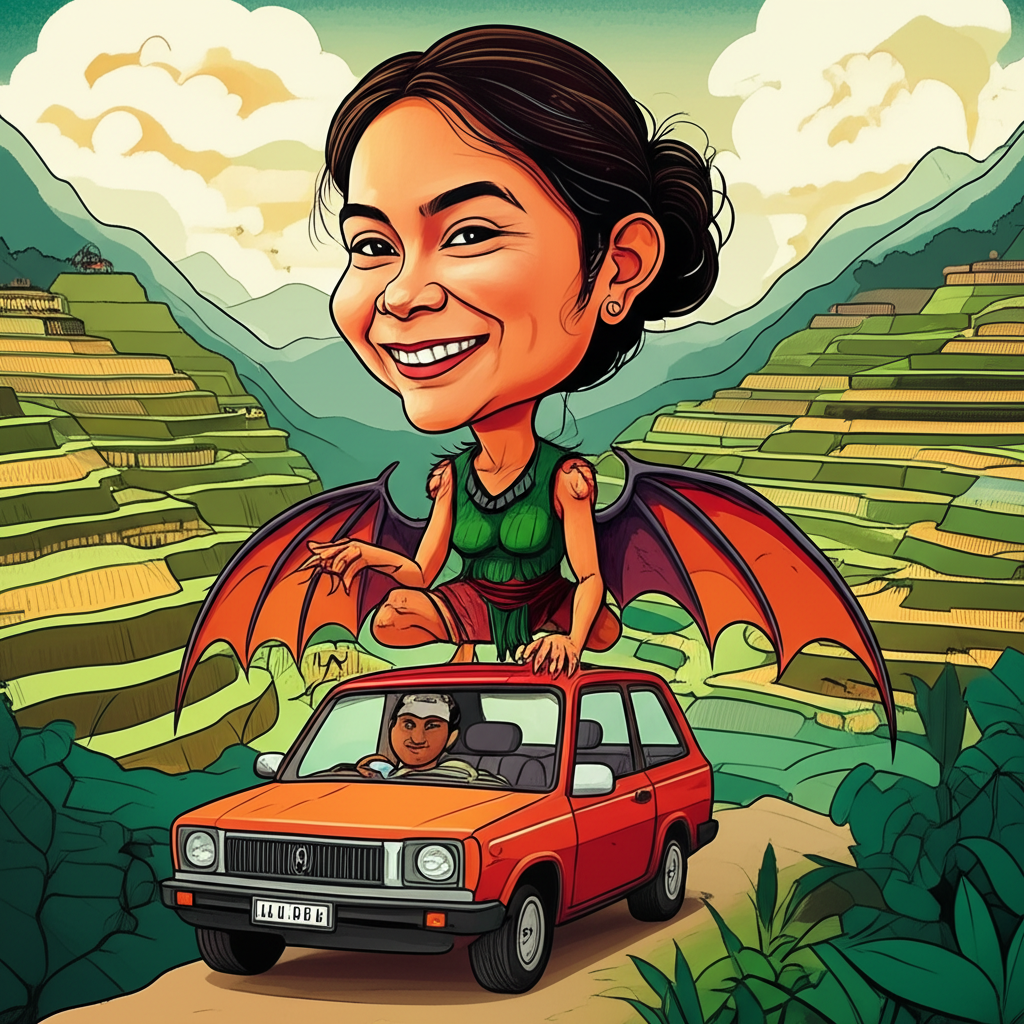
Deep within the emerald heart of the Philippine Cordilleras, where the land rises in an intricate stairway to the heavens, lies a tapestry woven from human ingenuity and the enduring presence of ancient tales. This is the domain of the Ifugao people, creators of the magnificent rice terraces, and the setting for a rich oral tradition that speaks of unseen forces and primordial beings. The narrative we are about to explore, "Echoes of Anitun Tabu – Kapre – Ifugao Terraces," is not a factual account, but rather a traditional story, a product of the imaginative minds of ancient people, offering a glimpse into their profound connection with nature and their explanations for the world around them. It is presented here purely for cultural, historical, and educational understanding, recognizing it as a fascinating fragment of human storytelling.
Origins and Cultural Background: A World Alive with Spirits
The roots of this narrative stretch back to a time before recorded history, flourishing within the pre-colonial societies of the Philippines. For communities like the Ifugao, life was inextricably linked to the land, the rhythm of the seasons, and the unpredictable whims of nature. Their existence was agrarian, revolving around the cultivation of rice, and their worldview was animistic. They perceived the world not as inanimate matter, but as a vibrant realm teeming with spirits – benevolent and malevolent – residing in trees, rivers, mountains, and the very air they breathed.
In this cultural era, the concept of "gods" or "spirits" served to explain phenomena beyond human control or comprehension. The thunder rolling across the mountains, the gentle kiss of rain on parched soil, the sudden fury of a typhoon – all were attributed to the actions of powerful entities. Their daily lives were guided by rituals and customs designed to appease these spirits, seek their favor, or ward off their wrath. The construction of the Ifugao Terraces, an engineering marvel often dubbed the "Eighth Wonder of the World," was not merely a feat of labor but also a sacred undertaking, performed in harmony with the perceived spiritual landscape. It was within this context of deep reverence for nature and a belief in unseen forces that tales like those involving Anitun Tabu and the Kapre took shape, providing meaning and order to their universe.
The Mythical Presences: Anitun Tabu and the Kapre
At the heart of our narrative stand two prominent figures from Philippine folklore: Anitun Tabu and the Kapre. Anitun Tabu, originating from Tagalog mythology, is revered as the ancient goddess of wind and rain. She is often depicted as a beautiful, ethereal being, her presence marked by the rustling leaves and the gentle patter of life-giving showers, or conversely, by the tempestuous gales and torrential downpours that could bring both bounty and destruction. Her symbolic attributes speak to the duality of nature’s power – the nurturing force that sustains life and the formidable power that can reshape landscapes. To ancient peoples, she embodied the essential, yet unpredictable, element of water and air that governed their harvests and their very survival.
The Kapre, on the other hand, is a more grounded, albeit equally imposing, figure found across various Philippine mythologies. Often described as a towering, hairy giant, with dark skin and a powerful build, the Kapre is most famously associated with old, large trees, particularly the balete tree. Its signature characteristic is a perpetually lit cigar, whose glowing embers are sometimes mistaken for fireflies in the twilight. Unlike the divine Anitun Tabu, the Kapre is often portrayed as a mischievous, sometimes solitary, guardian of the forests. It is not inherently evil, but its immense size and cryptic nature inspire both awe and caution. It symbolizes the untamed wilderness, the ancient sentinels of the forest, and the unknown forces that dwell in the deep woods, reminding humans of the vastness and mystery beyond their cultivated fields.
The Main Story: Whispers on the Wind, Shadows in the Trees
In a time when the Ifugao terraces were still being meticulously carved from the mountainsides, a testament to generations of toil and vision, the whispers of the wind carried more than just the scent of pine and damp earth. They carried the presence of Anitun Tabu, the goddess of rain and wind, who watched over the industrious people from her abode amidst the clouds. She admired their unwavering spirit, their hands calloused from shaping the earth, their voices raised in chants to honor the spirits of the land. It was her life-giving rains that filled their ingenious irrigation channels, nourishing the young rice shoots, ensuring sustenance for the burgeoning communities.
Yet, not all spirits were as benevolent or as easily understood. Deep within the ancient, gnarled forests that bordered the nascent terraces, a Kapre named Ambus lurked. Ambus was a creature of immense age and solitude, a guardian of the primeval woods that had stood long before human hands began to reshape the landscape. His massive, dark form was often obscured by the canopy of the oldest balete trees, his glowing cigar the only sign of his watchful presence. He viewed the humans’ relentless progress with a mixture of curiosity and possessiveness. Their axes chipped away at his ancient domain, their fires sent smoke curling into his air, and their joyous shouts sometimes disturbed his age-old slumber.
One season, a prolonged drought gripped the Cordilleras. The sun beat down relentlessly, cracking the earth and wilting the precious rice plants. The communal prayers to Anitun Tabu grew desperate. The goddess, observing the suffering, felt her heart heavy. She knew the land needed a profound soaking, a deluge to break the dry spell. However, Ambus, the Kapre, had grown restless. The lack of rain meant dry leaves, a parched forest, and a disruption to the delicate balance he guarded. In his silent, brooding way, he began to project a formidable aura, a barrier of unseen force, subtly influencing the air currents, making it difficult for Anitun Tabu’s rain clouds to gather directly over the terraces. He felt that the humans, in their ambition, had perhaps taken too much from the land, and this drought was a natural consequence.
Anitun Tabu, sensing the Kapre’s resistance, chose not to confront him with force. Instead, she manifested as a gentle breeze, carrying the faint, mournful songs of the Ifugao children, praying for rain, up into the higher reaches where Ambus dwelled. The breeze whispered through the ancient leaves, telling tales of the terraces, not as a conquest, but as an act of profound devotion to the land, an effort to sustain life in a difficult terrain. It spoke of the intricate systems designed to work with the mountains, not merely against them.
Ambus, usually impervious to human sentiment, felt a flicker of something akin to understanding. The songs were not demands, but pleas born of desperation and an abiding love for their land. He had seen generations of Ifugao respect the sacred groves, never felling the oldest trees, always leaving offerings at the foot of the balete. Perhaps their endeavor was not an affront, but another expression of the earth’s own resilience. Slowly, deliberately, Ambus began to lower his unseen barrier. The oppressive stillness in the air lifted.
With the Kapre’s subtle acquiescence, Anitun Tabu gathered her strength. Dark clouds, heavy with promise, began to roll in from the distant seas. First, a gentle drizzle, then a steady downpour, washing over the parched terraces, filling the cracks, revitalizing the wilting rice. The Ifugao people rejoiced, offering thanks to the unseen powers that had answered their pleas. Ambus, from his perch, watched the life return to the land, the shimmering reflections of the sky in the newly flooded paddies. He saw the humans’ enduring spirit, mirrored in the tenacity of the very mountains they had sculpted. He understood then that while he guarded the ancient, wild heart of the land, Anitun Tabu nurtured the cultivated soul, and together, their influences maintained a delicate balance in this remarkable world. The echoes of Anitun Tabu’s rain and the Kapre’s silent vigil became an intrinsic part of the terraces’ enduring legacy, woven into the very fabric of the landscape.
Symbolism and Meaning: Lessons from the Ancient World
This layered narrative, while a work of imagination, carried profound significance for the ancient Ifugao people. Anitun Tabu embodied the critical dependence on natural forces for survival. Her presence underscored the essential role of rain in their agricultural society, representing both the life-giving abundance and the potential for devastating scarcity. The Kapre, guarding the ancient forests, symbolized the untamed wilderness and the wisdom of respecting nature’s boundaries. It served as a reminder that humanity, even in its most ambitious endeavors, remained interconnected with, and at the mercy of, the larger natural world. The Ifugao Terraces themselves, in this context, symbolize human ingenuity, perseverance, and the deep spiritual relationship between people and their environment. The story, therefore, spoke to the balance between human effort and nature’s power, the necessity of respect for the environment, and the acknowledgement of unseen forces that shaped their world. It was a moral compass, guiding their interactions with the land and with each other.
Modern Perspective: Echoes in Contemporary Culture
Today, the tales of Anitun Tabu, the Kapre, and the magnificent Ifugao Terraces continue to resonate, albeit through a different lens. In modern Philippine literature, film, and video games, these mythological figures are often reimagined, sometimes as benevolent spirits, other times as formidable antagonists, adding depth and cultural flavor to contemporary narratives. The Kapre, in particular, frequently appears in horror folklore and fantasy genres, its imposing figure and cigar-smoking habit making it an instantly recognizable and intriguing character.
Beyond entertainment, these myths are vital subjects in cultural studies and anthropology. They offer invaluable insights into pre-colonial Filipino worldviews, social structures, and environmental philosophies. The Ifugao Terraces, a UNESCO World Heritage site, stand not only as a testament to engineering prowess but also as a living monument to the cultural heritage that produced such rich narratives. Studying these stories helps preserve indigenous knowledge systems, foster cultural pride, and reminds us of the universal human impulse to make sense of the world through imaginative storytelling.
Conclusion: A Heritage of Imagination
The narrative of Anitun Tabu and the Kapre amidst the Ifugao Terraces is a vibrant thread in the rich tapestry of Philippine mythology. It is a testament to the ingenuity and imaginative spirit of ancient peoples who sought to understand their world, explain its mysteries, and imbue their surroundings with meaning through compelling tales. As Muslims, we recognize that only Allah (God) is the true Creator and Sustainer of the heavens and the earth, the Giver of rain, and the One Who designed the intricate balance of nature. These traditional stories, while fascinating, are not to be believed or worshipped as truth.
Instead, they serve as precious cultural artifacts, offering a window into the human condition across different civilizations and eras. They remind us of the enduring power of storytelling, the universal quest for meaning, and the profound connection humanity has always felt with the natural world. The echoes of Anitun Tabu and the Kapre, therefore, continue to whisper not of divine power, but of a rich cultural heritage, an imaginative past, and the timeless tradition of narratives that shape identity and understanding.





